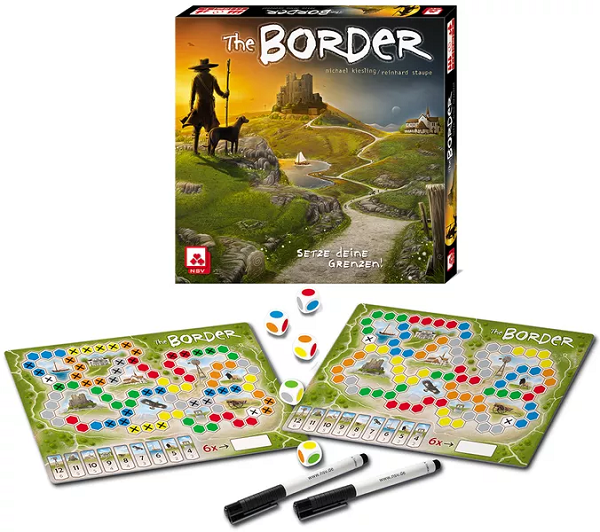Race to Build Borders Using Dice Rolls in The Border

Roll the dice and mark off spaces — but choose what to reroll wisely, because the dice you don’t use are the ones your opponents will be using.
Published by NSV and designed by Michael Kiesling (Azul) and Reinhard Staupe (The Game: Face to Face), The Border plays in twenty minutes and accommodates three-to-four players.
Gameplay
Each player takes a player board. Each board shows interconnected sets of colored spaces, coming in six different colors. The sets vary in size from two to five. The different boards all have the same layout, but the location of color sets varies from board to board. These colored spaces are all connected to one another and encircle nine different areas.
On your turn, you are the active player. You take the five dice and roll them. You may reroll up to two times, setting aside or rerolling any dice you choose. Then, using the dice you set aside, you may mark off a space on your board whose color matches the colors of the dice you rolled — however, you may only do so if you rolled enough of that color to mark off all the unmarked spaces in that set. So, for example, to mark off a set of three connected grey spaces, you must have rolled at least three greys on the dice. You may mark off multiple sets on your turn if the dice allow.
Next, each non-active player may use any or all of the dice that you were unable to use as the active player. They do not need to be able to finish a color set, but the spaces marked must be adjacent to a previously marked-off space (in addition to being the same color as the dice). If you were unable to use any of your five dice, they may use all of them. If you were able to use all five of your dice, they may choose to use one of your dice.
Once a player has managed to mark off all the spaces that surround an area, he announces it. If he was the first player to surround that specific area, he earns the higher point value for doing so. All other players that manage to surround that area for the rest of the game will earn its lower point value. The game ends once someone has managed to complete six areas and the turn is over. Then the player with the most points wins the game.

Review
There are some intriguing choices in The Border. The fact that the dice you don't use can be used by your opponents makes the decision of which ones to reroll much trickier. This also brings more weight to the push-your-luck element. Do you reroll, trying for a better outcome for yourself? But currently the dice aren’t going to help your opponents so maybe it’s better to leave the dice where they lie.
This also leads to an interesting escalation within the game and changes the balance as you progress. As more and more boxes are marked off on your board, you’ll have more spaces you can mark off on your opponents’ turns. So while at the start of the game, the active player role is more valuable, often by the end you’re getting more done on other people’s turns.
There are some component issues, however. The red and the orange faces on the dice can be difficult to tell apart under certain lighting conditions, and the dry erase markers included do not have erasers to wipe off your board. The player boards are also not very thick and the dice are quite lightweight and not as enjoyable to roll as something with a bit more heft. There is, however, a nice felt lining on the inside of the game lid, ideal for rolling the dice on.
Additionally, the theme doesn’t quite make sense. You are supposedly closing borders, but you’re marking off areas inside the country as well as the border all around it. The areas could be representing individual counties, but that doesn’t quite tie in with the game’s tag line of ‘close your borders.’ Consequently, the theme, while not a major part of the game, just doesn’t mesh with the gameplay itself.
Despite these issues, The Border brings some clever ideas to combine the push-your-luck with player interaction, without complicating the rules.
Pros: Balancing rerolling the dice with what dice will be available for your opponents, simple rules, felt-lined box lid for dice rolling
Cons: Component quality could be improved, theme and gameplay don’t really match
Disclosure: we received a complimentary review copy of this game.






